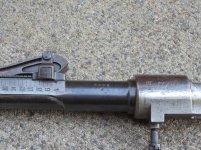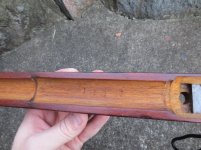CM0087
Senior Member
Picked this up last year from off a tip from a bloke I shoot with at the local range. Set me back $400, which is pretty good (Gew 98's don't turn up much down under)
1917 Haenel Gew 98 WWI bring back. I'm told it came back 100% matching, but over the years somehow the cleaning rod and saftey were lost (have been replaced with un-numbered examples). Other than that, rifle matches to the screws. Unfortunately, the rifle was neglected for many many years until the gentleman I purchased it from bought it from the grandson of the digger who brought it home after WW1. Severe pitting on the right side of the barrel towards the muzzle, and pretty heavy patina on the receiver area (looks rust coloured in some photos, that's the camera flash; it's actually a grey/black colour.)
The stock was treated, and was an ugly yellowish colour. I just got it back from S/42 today, who did an absolutley outstanding job to return it to how it would have looked in 1917
 thanks mate!
thanks mate!
Anyway, here she is. She's nothing great to look at compared to most of the examples on here, but she'll do until I find another.
1917 Haenel Gew 98 WWI bring back. I'm told it came back 100% matching, but over the years somehow the cleaning rod and saftey were lost (have been replaced with un-numbered examples). Other than that, rifle matches to the screws. Unfortunately, the rifle was neglected for many many years until the gentleman I purchased it from bought it from the grandson of the digger who brought it home after WW1. Severe pitting on the right side of the barrel towards the muzzle, and pretty heavy patina on the receiver area (looks rust coloured in some photos, that's the camera flash; it's actually a grey/black colour.)
The stock was treated, and was an ugly yellowish colour. I just got it back from S/42 today, who did an absolutley outstanding job to return it to how it would have looked in 1917

 thanks mate!
thanks mate!Anyway, here she is. She's nothing great to look at compared to most of the examples on here, but she'll do until I find another.
Attachments
-
 IMG_0301.jpg275.7 KB · Views: 122
IMG_0301.jpg275.7 KB · Views: 122 -
 IMG_0314.jpg316.4 KB · Views: 142
IMG_0314.jpg316.4 KB · Views: 142 -
 IMG_0315.jpg317.2 KB · Views: 140
IMG_0315.jpg317.2 KB · Views: 140 -
 IMG_0316.jpg319.8 KB · Views: 114
IMG_0316.jpg319.8 KB · Views: 114 -
 IMG_0317.jpg290 KB · Views: 105
IMG_0317.jpg290 KB · Views: 105 -
 IMG_0324.jpg280.2 KB · Views: 108
IMG_0324.jpg280.2 KB · Views: 108 -
 IMG_0328.jpg277.4 KB · Views: 116
IMG_0328.jpg277.4 KB · Views: 116 -
 IMG_0326.jpg286 KB · Views: 137
IMG_0326.jpg286 KB · Views: 137 -
 IMG_0325.jpg286.5 KB · Views: 105
IMG_0325.jpg286.5 KB · Views: 105 -
 IMG_0327.jpg293.4 KB · Views: 138
IMG_0327.jpg293.4 KB · Views: 138






 LOL. The bore is dark but with strong rifling, but the corrosion at the forend under the wood is pretty bad (although safe to shoot)
LOL. The bore is dark but with strong rifling, but the corrosion at the forend under the wood is pretty bad (although safe to shoot)
